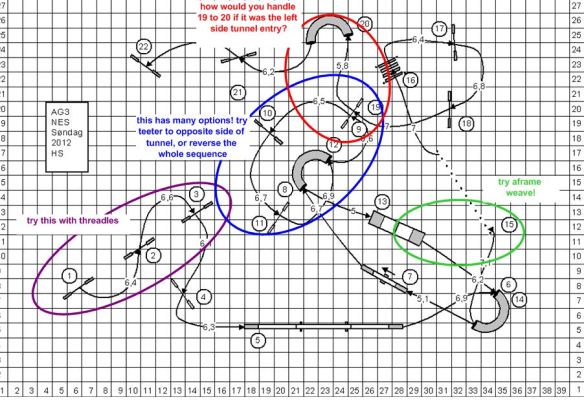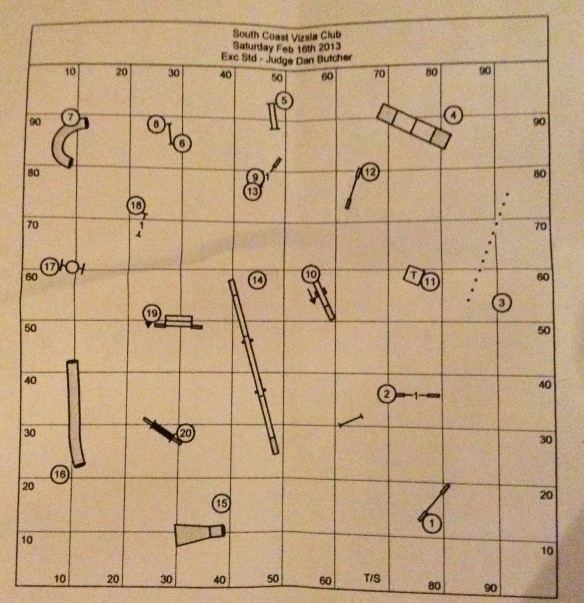As published on USDAA.com at http://www.usdaa.com/article.cfm?newsID=2773
Tag Archives: fun agility course
Ring Around The Tunnel; Pocket Full of Kibble
As published on USDAA.com at https://www.usdaa.com/article.cfm?newsID=2801



- Start with the dog on your left.
- Front cross the approach side of the #2 tunnel.
- Send the dog to #4 tunnel.
- Blind cross before the dog exits #4 tunnel.
- Blind cross again at the entrance to #6 tunnel.
- Rear cross on the approach side of #8 tunnel.

Snooker 101: How To Play USDAA Snooker With FLOW & FUN!
***Disclaimer- I am teaching you how to play Snooker with your dog’s happiness as a priority and to get a Q. If you want to learn Snooker strategy to win and get Super Q’s, please read Dave Hanson’s Snooker article at http://www.usdaa.com/binary/files/SnookerHanson.pdf
Snooker is a game played in USDAA agility. It involves an opening of the handler’s choice and a closing of the judge’s choice. Red jumps are taken, and IF completed successfully, allow the opportunity of taking a numbered/colored obstacle. In the opening, numbered/colored obstacles, earn points if completed successfully. If NOT complete successfully in the opening, you earn no points but can continue. In the closing, if a numbered/colored obstacle is NOT completed successfully, the whistle blows.
ALWAYS read your Snooker course map and go to the briefing so you will know if it is 3 reds, 4 reds OR 3 or 4 reds, (or 4 of 5 reds, or…)! You also need to know the time set for the course, as well as any other judge specific rules (#6A and #6B must be taken in flow, or combo #5 is any jump weaves, etc.)
It is best to look at designing your Snooker strategy by working BACKWARDS from the closing. Always look at the closing, determine where number 2 is and how is the best way to get there from your opening.
Pick an opening sequence that utilizes FLOW. Even a Super Q can happen with a course that runs smoothly. In Advanced and Starters, FLOW should be the number one priority! Get your minimum points on a course that allows your dog to work in extension, keep it safe and fun!
You only need 37 points to qualify in Snooker. If you make it through the closing to number 7 you have earned 27 points; you only need 37 to qualify, so that makes a total of 10 points needed in the opening. Or you could plan on getting through number 5 in the closing, and then you would need 23 points in the opening. Or. Or. Or. Get out a calculator!!
Red jumps are worth 1 point and if taken successfully, allow you to take a numbered/colored obstacle for points. YOU CAN ONLY TAKE A RED JUMP ONCE IN THE OPENING.
Start with the hardest to get to red jump and end with the red jump that flows into the number 2 of the closing.
Your course needs to consist of the following: red jump, numbered/colored obstacle, red jump, numbered/colored obstacle, red jump, numbered/colored obstacle, 2, 3, 4, 5, 6, 7.
Think of the opening and the closing as a course! Renumber it on your course map starting with 1 and ending with whatever number gets you to the last part of the closing. I know you are allowed to “think on your feet” in snooker, but some dogs can’t handle the stress and will shut down. I do not “think on my feet” with those dogs. I run my course and leave if a whistle sounds! I do not sacrifice my dog’s happiness and speed for anything!
Technically you can go to another red if your dog has performed a red incorrectly by knocking it. I reserve this strategy for DAM/PVP. Again, I run my course in flow and if the whistle blows, I leave!
**Try to plan a course that is do-able for your dog; don’t plan on 3 weave poles when your dog misses entries. Make sure you can complete the course in the time allotted, weaves and contacts take longer than jumps and tunnels!
Refusals do not count in the opening, and do count in the closing.
If you fault a numbered/colored obstacle, you MUST complete it in the opening.
Snooker Checklist
- Find hardest red jump, start your opening with that jump
- Find #2 obstacle, plan to end your opening close to #2
- Walk the closing
- Plan an opening with flow
- Re-number your course map
- Memorize the opening and closing as one course
- Plan a reasonable course for you and your dog’s skills
- Leave when the whistle blows
Here is a fun course from cynosports 2014 to study and come up with a plan that has FLOW and is FUN for your dog!
Here is Eric’s briefing:
Start jump is bidirectional, must be taken to start your run and if taken again, ends your run! The finish jump is live at all times and will end your run!
3 or 4 reds!
Combos are bidirectional in the opening!
Times:
- Champ 26/22 and P 20/16 45 secs
- Champ 18/16 and P 12 50 secs
- Champ 14/12 and P 8 55 secs
International Agility WOOT!
Very cool Dog Agility Blog Event on Internationalization !!
The technology available to agility competitors has increased the ability to do agility at a different level. Videos of competitors from around the world have inspired interest in worldwide agility skills. International course design is cropping up in AKC and USDAA in the form of threadles, backsides and other global sequences. USDAA has added a Master Challenge course that has many international course features which can be found in DAM Team courses as well.
My favorite course map website has international courses from the judges overseas at http://pompilio.wordpress.com/ I like to print out courses and set them up to work on the challenging pieces as well as re-number and try new sequences from the same course. My students enjoy the options and I try to embed shorter/less complicated sequences that people with young dogs can do within the harder course so that there are level appropriate sections for everyone.
Here is a course we are going to run tonight that was designed by Harald Schjelderup. He is going to be a judge at the FCI World Championships.
There are multiple options to try within this course, and I am sure I will come up with more tonight!
This is a link to a previous blog post regarding a Harald Schjelderup international jumpers course with different options to try https://ffluffy.com/2013/02/15/harald-schjelderup-agility-course/
Cardboard and Girl Scout Cookies VS Fun Agility Courses and a Bottle of Wine
A woman who meant well offered me cardboard to “keep me warm” the last night I was camping at the agility trial. I was dirty and dressed in my awesome striped PJ’s pants and mismatched top. I thanked her gratefully and suggested she leave it by the dumpster for the next person who might need it. I also learned that Grasshopper Cookies ($2 at walmart) taste as good as or better than Girl Scout Thin Mints ($4 from your local girl scout). I know this sounds too good to be true but we did a genuine taste test around the campfire. It might have been the beers, but I swear the Grasshoppers won out. And you can buy them year round!!! Woot!
To top the weekend off I scored an AMAZING bottle of wine from some good friends, got to run a really cool dog (sorry about the ankle) and watched a cool MACH Run! More WOOT!
Check out these two courses by Dan Butcher from this weekend. Some neat challenges that kept people on their feet and caught a few of us off guard! My best advice to the worry warts: #wootyurlife It’s the only option when the doubt flies in, just kick it out with some heartfelt woot and even if you don’t Q you can still feel AWESOME!!! LOL!
Can’t wait for next weekend; I’m running for margaritas!!!!






